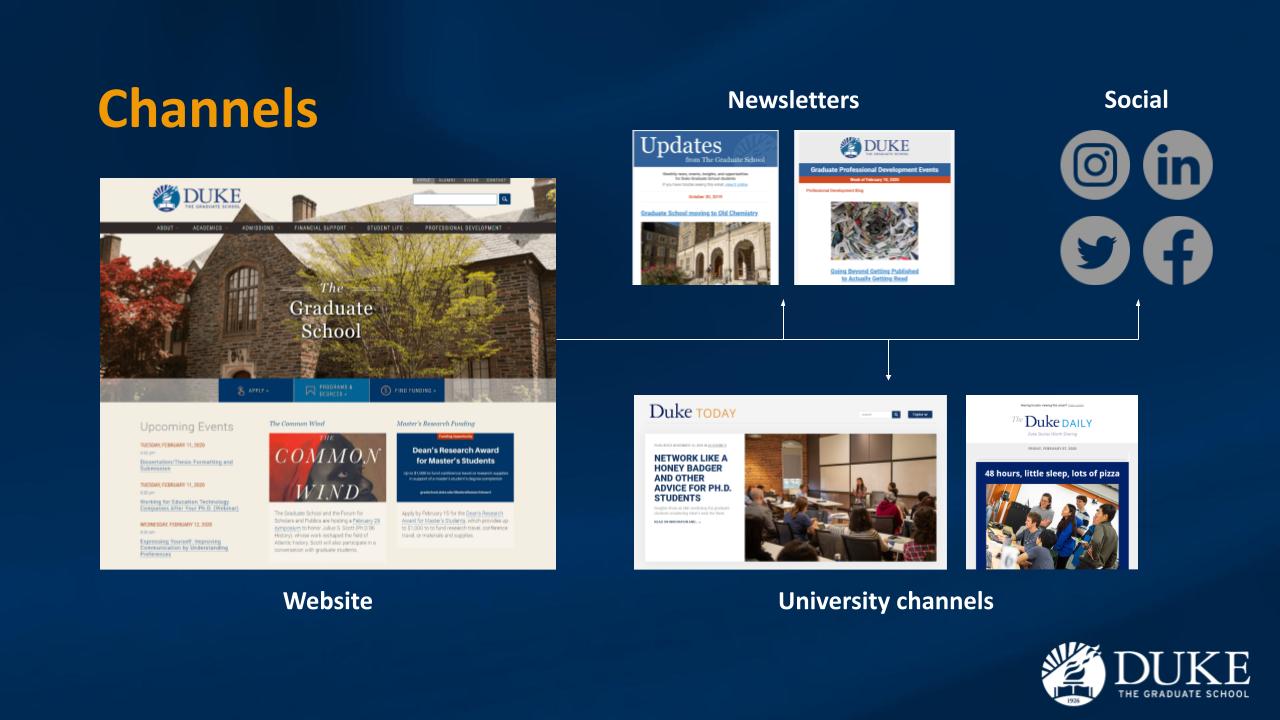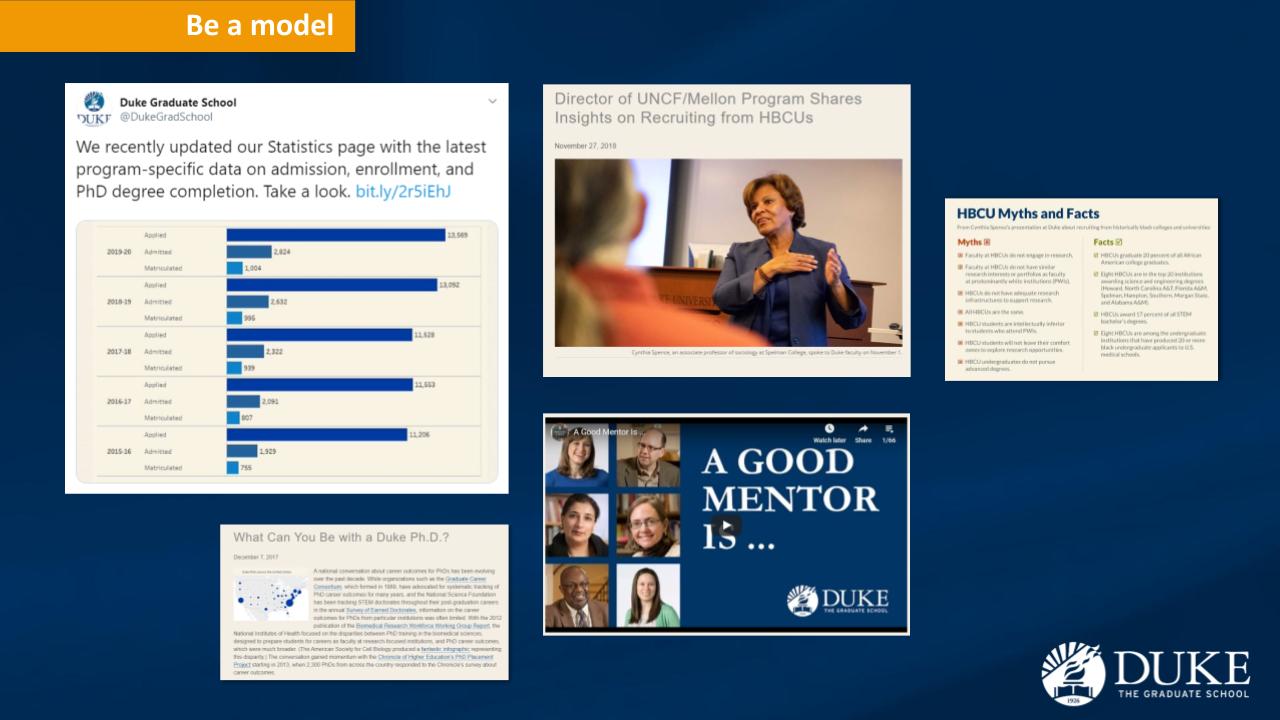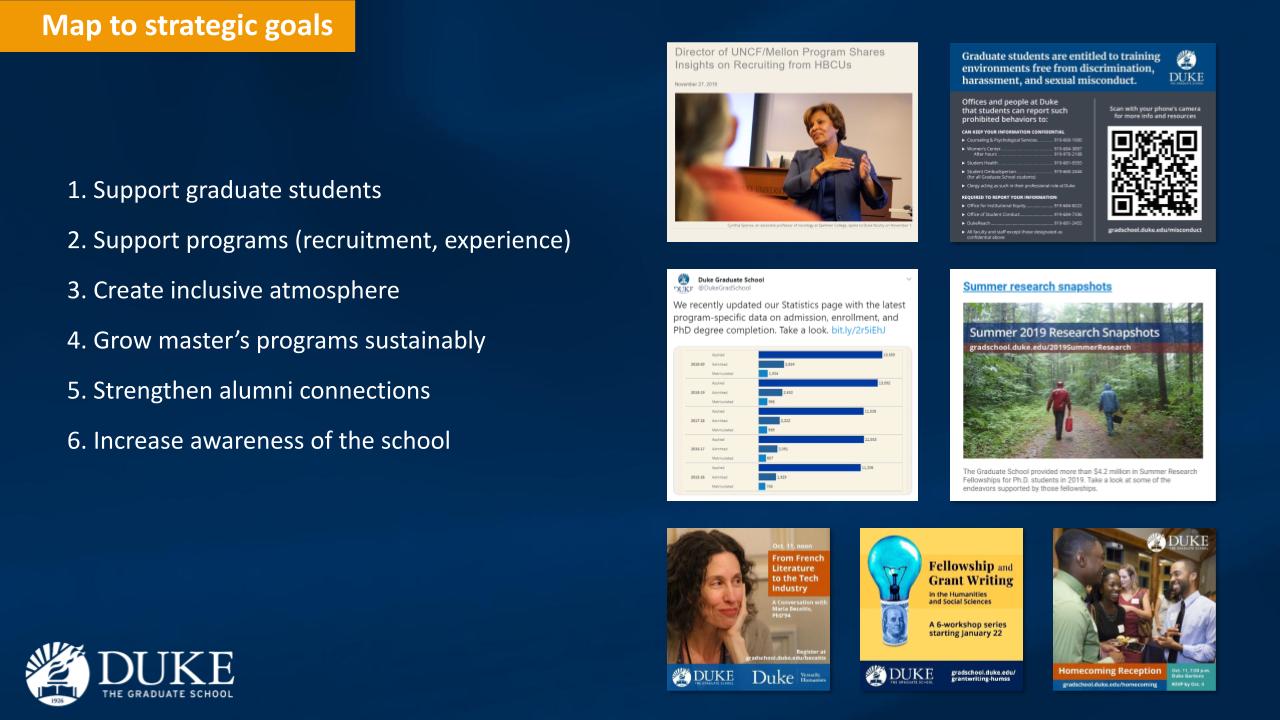communications and content
Duke Graduate School Communications Strategy
The Duke University Graduate School supports 3,500-plus PhD and master’s students across 80-plus graduate programs. However, because its students spend most of their time in “home departments” spread out across Duke, the Graduate School’s role in those students’ experience is often overshadowed. This can keep students from taking full advantage of the resources provided by the school and hamper the school’s efforts to raise more funds that go toward financial support for its students.
During my time as Senior Director of Communications for the Graduate School, I developed and implemented a communications strategy to address that challenge. Over the span of several years, that strategy increased the school’s visibility online and on campus, supported the school’s strategic goals, and conveyed the importance of the school’s work to a wide range of key audiences.
Core themes
My communications strategy aligned and bolstered the school’s strategic plan (which I also developed). In the strategic plan, we distilled the school’s value to its students and to Duke down to a succinct descriptor: the ultimate facilitator of the best people and the best work. This captured the school’s role in recruiting outstanding students and providing them with the support they needed to thrive at Duke, which in turn benefitted from those students’ research, teaching, and service.
Building our communications strategy around that theme, I identified key areas of the school’s work that illustrated how it facilitated the best people and the best work. This included, among other things, financial support, professional development, mentoring resources, advocacy for students, and building a diverse and inclusive community. These became core areas of emphasis in our communications.
Key audiences
I homed in on our current graduate students as the Graduate School’s primary audience, because they are the ones who interact with and benefit the most from the school’s work. They also are future alumni and supporters, so focusing school communications around the interests and needs of this group made sense. Our secondary audiences included prospective students, the faculty and staff who support graduate students, and alumni and supporters.
Channels
With current students as our primary audience, we focused on channels aimed at the on-campus community. This included university-wide vehicles such as Duke’s news website, daily newsletter (which went to everyone at Duke), and social media channels. As such, I began cultivating a strong working relationship with the communicators overseeing those channels so as to understand the type of content they wanted.
I also built up the Graduate School’s own channels. I revamped the school website so that it’s better suited to serving as a home for storytelling. I also launched the school’s presence on Twitter, Instagram, and YouTube, and made its existing LinkedIn and Facebook presence much more robust. In addition, I overhauled the school’s newsletter and started an annual report aimed at university leaders and supporters of the school.
Content
I dedicated significant effort to developing a steady stream of high-quality content on our own channels and university channels of interest. This encompassed long, medium, and short-form stories, multimedia pieces, and social media posts. Across all our channels, our content focused on informing the university community about the important role that graduate students played at Duke, and informing those graduate students about the important role The Graduate School played in their experience.
Our content was guided by six principles:
- Be useful: Our communications should be tailored to the specific needs and interests of the intended audience. For instance, with current students being our primary audience, we produced a significant amount of content about financial and other resources that they can use.
- Be efficient in how we create content: I was essentially a one-person shop, supported by 1-2 interns at any one time. So I always looked for ways to reuse and repurpose stories.
- Model best practices in graduate student support: Whether it’s emphasizing professional development, highlighting inclusive communities, or providing transparent statistics, our communications should practice what the school preached as keys to enhancing graduate education.
- Empower our students: Our communications should aim to give students actionable information, such as emphasizing policies and resources that protect them against harassment or reminding them about financial resources that they can apply to.
- Reflect what we do in real life: The communications should match the school’s priorities in real life and echo the caring, empathetic, and professional approach the school’s staff took toward student support.
- Map to our strategic goals: Our communications should tie back to the goals in the school’s strategic plan, such as improving support for students and programs, creating an inclusive atmosphere, strengthening alumni connections, and increasing awareness of the school.
Outcomes
Over several years, the communications strategy that I created yielded noticeable dividends. Engagement with our newsletters and social media channels steadily increased and held at robust levels (e.g., a 65 to 75 percent open rate for our main student newsletter). Stories about the school — typically created by me and my communications interns — began appearing with much greater frequency in university channels and publications. Content at the university level began to include or feature graduate students much more than before. Our alumni community became more engaged, and our fundraising results trended upward. Obviously many factors contributed to those outcomes, but the communications strategy was definitely a key part of those successes.





